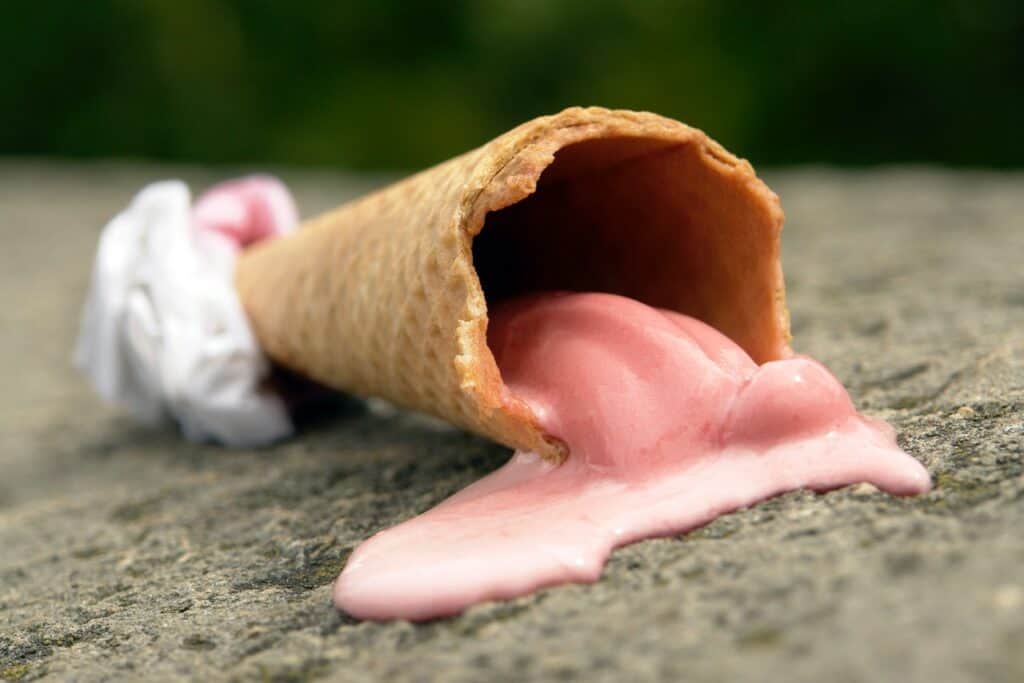If you enjoy ice cream, you definitely know that it does not last long in its solid state. Immediately after removing from the freezer, it melts very fast.
Ice cream loses its texture after melting. Also, the taste may be compromised, and it may not be as good as that of solid ice cream.
Essentially, ice cream constitutes a blend of sugar, oils, stabilizers, and flavors that are frozen to bring out the smooth ice cream texture. When melted, this perfect blend is lost and can also be harmful to your health.
However, if you want, you can still eat melted ice cream. Still, you should check how long it has stayed after melting.
Also, the condition of storage will determine the safety of the melted ice cream. Melted ice cream is prone to Listeria and, therefore, if consumed, can lead to severe food poisoning with symptoms such as fever and diarrhea.
If the ice cream has stayed for 2 hours after melting, you should not consume it. Neither should you refreeze it to eat it later. It may have been contaminated already by Listeria bacteria.

Can You Eat Melted Ice Cream
The nature of the products contained in the ice cream presents a significant issue related to food safety. Food bacteria are hardy and can withstand extreme temperatures.
Also, slight contamination can lead to the growth and multiplication of bacteria. For instance, salmonella can even withstand freezing temperatures.
With a period of 30 minutes, bacteria can replicate and multiply, doubling their original numbers. Bacteria only require suitable environmental conditions. Mostly, a warmer and moist environment is favorable for bacteria growth.
Bacteria such as salmonella and Listeria are common in egg and milk products. Most ice cream producers use these products together with oils, sugar, and stabilizers, among others.
It is common to have Listeria present even in frozen ice cream. However, strict measures during production prevent this contamination.
Once the ice cream is removed from the freezer, the warm and moist temperature provides the perfect condition for bacteria growth. Slight contamination will impose a considerable health risk since the bacteria multiply very fast.
Nonetheless, if the ice cream is not contaminated, it is safe to eat it within 2 hours. The problem is that it is almost impossible to detect the presence of Listeria or any other bacteria present. They are microorganisms and can only be seen using a microscope.
If the melted ice was in the refrigerator, it might be safer than at room temperature. However, it still depends on whether the melted ice cream had been exposed to bacteria.
Remember that even handling it with unwashed hands can contaminate it with bacteria. It is the reason you are advised not to use your nails when eating ice cream.
Nonetheless, remember that bacteria also thrive under refrigerated conditions. The fridge temperature is not enough to freeze the ice.
The surroundings of the refrigerator are moist and offer a suitable environment for bacteria growth. The growth may not be quick as in the case of room temperature, but the bacteria will still grow and multiply.
Therefore, avoid eating melted ice cream, especially if you do not know how long it has stayed in a melted condition. However, if it is only for a few minutes, it is as good as frozen. The texture may not be as good, but the taste is incredible.
Dispose of the melted ice cream if it has stayed in that condition for more than 2 hours. Else, you may experience stomach aches which can be severe.
Can You Refreeze Melted Ice Cream?
Most of the time, we refreeze melted ice cream to bring back its texture. You can refreeze melted ice cream, but you must be very careful. If contaminated, even freezing conditions cannot eliminate the bacteria present.
We must understand the nature of Listeria or salmonella, which are the common bacteria that may contaminate your melted ice cream. If you put contaminated ice cream in the freezer, the bacteria will hibernate and remain in an inactive condition.
The bacteria can stay in this state for years without dying. Once the ice cream is removed from the freezer and it starts melting, the bacteria will begin growing and multiplying. Bacteria thrive well in warm and moist temperatures and will multiply to contaminate your ice cream further.
Therefore, you might be putting your health at risk every time you refreeze your ice cream. However, it is safe to put your ice cream back in the freezer if it has only melted for a few minutes.
But if the ice cream had melted outside the fridge, the risk of contamination may be higher. Therefore, avoid refreezing ice cream that had melted at room temperature.
Outbreaks of food poisoning as a result of Listeria have been recorded even on frozen ice cream from the manufacturers. The bacteria can withstand freezing conditions and resurface once exposed to favorable temperatures and moisture.
Here’s the expert’s take on refreezing ice cream:
How Long Does Melted Ice Cream Remain Good?
Ice cream loses its texture after melting, and thus the taste may be compromised and may not be as good as hard ice cream. Ice cream is basically a mixture of different dairy products that are frozen to create a smooth ice cream texture.
These dairy products harbor Listeria bacteria. Importantly, eating melted ice cream that has stayed for more than 2 hours can be harmful to your health.
Depending on how long it was left after melting, you can eat it comfortably without any health risk issues. The storage condition will also determine the safety of the melted ice cream.
Storing in the refrigerator reduces contamination. However, bacteria will still grow in refrigerated conditions. Melted ice cream is susceptible to harmful bacteria and can therefore lead to severe food poisoning when consumed.
In addition, you should not refreeze it to eat later. Listeria bacteria may have already contaminated the ice cream.
Does Ice Cream Have An Expiry Date?
Due to its irresistibility, most of us usually consume ice cream as soon as we purchase it. Therefore, we rarely have to worry about it going bad in our freezer. However, it is vital to understand how long ice cream can last in storage, especially for bulk buyers.
Most of the expiry tags in ice cream come with a “best before date.” It means that you can still enjoy your ice cream even after the stipulated best before date. However, this only applies to unopened frozen ice cream containers.
Unopened frozen containers can be stored at your home for one or two months. On the other hand, opened containers can be safely stored for up to three weeks. After the expiry date, the quality and the texture of the ice cream are not good.
Final Words
Ice cream is loved and enjoyed by many people. However, there are health hazards associated with melted ice cream. Ice cream is perfectly safe when consumed minutes after melting.
However, if the ice cream has melted for more than 2 hours, it should be disposed of since it can lead to food poisoning. Listeria is a common bacteria that thrive in contaminated melted ice cream. Refreezing the ice cream after contamination does not kill the bacteria.
Overall, it is unfortunate that both melted and refrozen ice cream pose a significant health hazard. Note that even thawing ice cream in the refrigerator also poses health safety issues.
We should always remove ice cream from the freezer only for a few minutes. In this case, the exposure to bacteria is limited. It would be best to dispose of any ice cream that has already melted.





